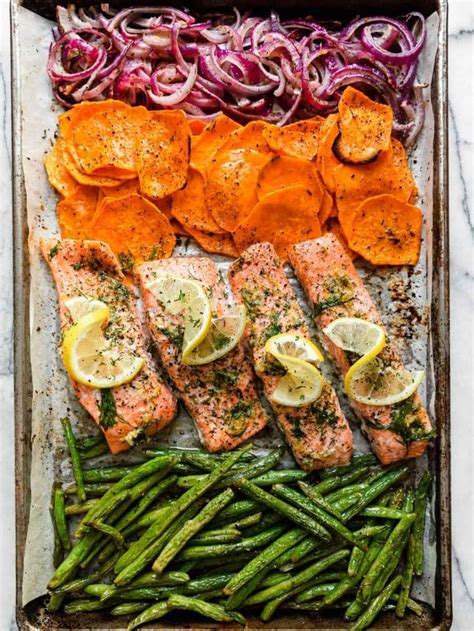Quick & Easy Salmon Dinners: Healthy and Fast
Sheet Pan Salmon and Veggies

Sheet Pan Preparation
This cooking technique offers unmatched convenience and efficiency. The sheet pan method requires minimal cleanup while delivering a nutritious, flavorful meal in significantly less time than traditional cooking methods. Begin by tossing your selected vegetables with olive oil, salt, pepper, and your preferred herbs or spices. Spread them evenly on a large baking sheet, making sure they're not overcrowded. Place seasoned salmon fillets atop the vegetables and drizzle with additional olive oil.
Temperature control makes all the difference in sheet pan cooking. A properly preheated oven ensures uniform cooking, bringing out the best texture and flavor in both salmon and vegetables. Maintaining consistent heat prevents uneven results. Adjust cooking times based on the thickness of your salmon and vegetable varieties.
Ingredient Selection
The recipe accommodates various vegetables - from traditional broccoli and asparagus to vibrant bell peppers and Brussels sprouts. Including colorful produce enhances both presentation and nutritional content.
Selecting premium salmon fillets significantly impacts the dish's final quality. Wild-caught salmon offers richer flavor, while farm-raised provides accessibility. Choose uniform fillet sizes for even cooking.
Herbs and spices shouldn't be an afterthought. Fresh dill, parsley, or thyme (or their dried counterparts) add complexity, while lemon zest or juice provides bright, fresh notes.
Cooking and Serving
Monitor the baking process closely once the sheet pan enters the oven. Precise timing ensures salmon reaches food-safe temperatures without becoming dry. A meat thermometer confirms when salmon reaches the ideal 145°F (63°C). Vegetables should achieve tender-crisp texture, and salmon should flake easily.
After removing from the oven, let the dish rest briefly before serving. A final garnish of fresh herbs or lemon juice elevates the presentation. Serve immediately for a complete, satisfying meal.
One-Pan Salmon with Lemon and Herbs

Preparing the Salmon
Start by thoroughly drying salmon fillets with paper towels. This essential step promotes crispy skin during baking. Proper drying allows the skin to develop optimal texture and flavor. Generously season with salt and freshly ground black pepper.
Place prepared fillets on a parchment-lined baking sheet to prevent sticking and simplify cleanup.
Creating the Lemon Herb Marinade
Combine fresh lemon juice, chopped herbs (dill, parsley, thyme, or rosemary), olive oil, minced garlic, salt, and pepper in a small bowl. This vibrant marinade permeates the salmon with fresh, aromatic flavors.
Arranging the Vegetables
While the salmon marinates, prepare your vegetables. Whether selecting asparagus, broccoli, cherry tomatoes, or bell peppers, strategic placement on the baking sheet ensures uniform cooking. Proper spacing prevents uneven results and maintains ideal vegetable texture.
Adding the Vegetables to the Baking Sheet
Arrange prepared vegetables around the salmon fillets, maintaining adequate space between pieces for proper air circulation.
Baking the Salmon and Vegetables
Preheat oven to 400°F (200°C). Bake for 12-15 minutes until salmon reaches doneness and vegetables achieve tender-crisp texture. Adjust timing based on fillet thickness and vegetable selection.
Checking for Doneness
Verify salmon reaches 145°F (63°C) internally using a food thermometer. Avoid overcooking to preserve moisture and flavor.
Serving and Enjoying
Allow the dish to rest briefly after removal from oven. Garnish with additional fresh herbs for enhanced presentation and flavor. Serve this complete one-pan meal immediately at its flavorful peak.

- Slow Cooker Comfort Food: Hearty Beef Stew Recipe
- Pantry Staples for Healthy Eating: Must Have Ingredients
- Keto Desserts: Guilt Free Sweet Treats
- Buying Organic Produce: Is It Worth the Cost?
- How to Choose the Freshest Seafood at Your Market
- How to Store Potatoes Long Term: Cool and Dark
- Baking Gluten Free Brownies: Fudgy and Delicious
- Vegan Lunch Ideas: Creative and Satisfying
- Vegetarian Lunch Ideas: Wholesome and Satisfying
- Homemade Nut Milks: Dairy Free Alternatives
- Storing Leftover Wine: Preserve Flavor
- Healthy Snacks for Adults: Smart Choices for Busy Days